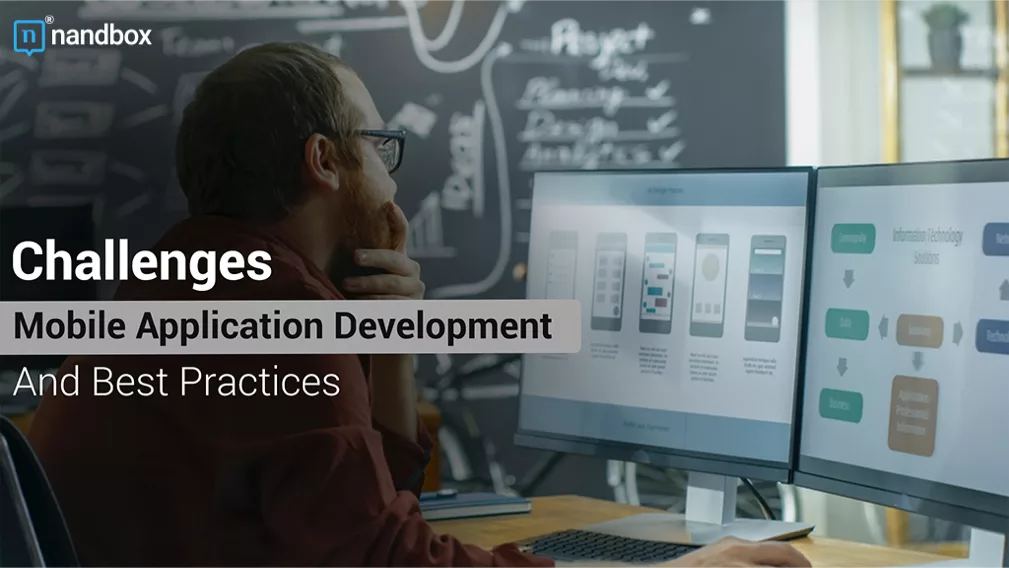When building an app, it is important to consider the different types of challenges in mobile application development that you may face. Some common challenges include: selecting a development path, making sure the app is user-friendly, making the app compatible with different devices, standing out in the app industry, securing the app, keeping your app up-to-date, monetizing the app, and funding the launch phase.
There are ways to solve each of these challenges. And it is important to be aware of them before starting to build an app. As a matter of fact, 80% of these challenges are easy to skip through nandbox App Builder.
Top 8 Challenges In Mobile Application Development
1. Selecting A Development Path
After identifying the app idea, you should identify the method of development. Are you willing to hire a team of developers? Or sign a contract with a coding agency? Alternatively, you might create it manually using a platform that does not require you to know how to code and can make you publish your app in almost no time, such as nandbox.com.
This decision is related to the knowledge you have of the mobile application industry. The budget you allocated for your app, and the time you want to spend on the app-building process.
2. Creating A User-friendly Experience
User experience is one of the most important aspects of any mobile application. It is the first impression that your customers get about your brand, so it needs to be carefully considered.
To make an app user-friendly, consider the following: use intuitive design, use clear and concise text, and use familiar icons. Intuitive design means that the app is easy to use and understand. Clear and concise text means that the words are easy to read and understand.
A well-designed user interface (UI) can make an application easy to use. While a poorly designed UI can make it difficult or even impossible to use. When designing your app, there are a number of considerations that must be taken into account, including the overall look, functionality, and usability.
3. Empowering Compatibility With Different Devices
To make an app compatible with different devices, your app’s user interface needs to be responsive, which means that the app will adjust to different screen sizes. Which is the main technology to create a mobile app that works on all devices, whether it’s a smartphone, tablet, smartwatch, etc.
4. Securing the App
App security is important to consider when building an app. To make your app secure, consider the following: using data encryption, using user authentication, and using a secure server. Data encryption means that the data is turned into a code that can only be read by authorized people.
User authentication means that in order to use the app, users must first authenticate themselves through the app’s login process.
Servers are considered secure if they use any secure sockets layer protocol to protect communication from being intercepted by those who are not intended to access it.
5. Standing Out In The App Industry
According to Statista: the amount of money people spend on mobile apps has seen solid growth, reaching 170 billion U.S. dollars in 2021.
In the second quarter of 2022, the total amount spent through apps was 33 billion dollars. To learn why people should download your app and to propel its current presence into a financially sustainable phase, you’ll need to devise a strategy that will lead you to attract clients.
How To Make A Customer Acquisition Plan?
1. Know more about your ideal users.
Where do the majority of them live? What interests them? What social platform do they use?
2. See how your competitors reach them.
In today’s market, there is competition in every industry, and it’s a good sign to show if the market is active and profitable or not. Also, observe and notice how your competitors reach your targeted audiences.
3. Set your marketing goals.
Setting goals will help you mentor your growth and identify your weak points.
4. Create your marketing material “acquisition funnel.”
Here, you design a strategy for reaching your desired audience; you may focus on digital advertising or on classic methods like posters and word of mouth. In this case, you can consider using poster templates and poster maker, graphic design tools, and other digital solutions for greater effectiveness.
5. Track everything and always improve your app’s services.
Knowing your numbers and your position in the market is critical for empowering growth.
6. Keeping Your App Up-to-date
App updates are important for security and adding new features. To update an app, consider the following: use a version control system, use an automated build system, and use a code signing service.
A version control system keeps track of different versions of the app. An automated build system compiles the code and creates the app package. Finally, you will not need to worry about any technical issues if you build your app with nandbox App Builder.
7. Monetizing Your App
App monetization is the process of making money from an app. There are many ways to monetize an app, and the best way depends on the app and the audience. Ads, in-app purchases, subscriptions, and paid downloads are all common ways to make money with an app.
8. Funding The Launch Phase
Creating a mobile application might cost you thousands of dollars or less than one hundred dollars, depending on how you develop and market your app. So you should consider how much your app will cost until it becomes well-known in the market and how you will be able to pay for it.
Having a fantastic concept for a mobile application will not be real if you lack the financial resources to turn it into a working product. You have a number of options available to you in terms of how you might get funding. Some of the ways to do this are through angel investors, payday loans, and joint ventures.
For solopreneurs who are afraid of any challenges in mobile application service and do not have a huge budget or a skilled technical team.
The best option is to try nandbox app builder, which allows you to scale up as much as you want and publish to the major app markets (Google Play and Apple App Store). It’s the most comprehensive native app builder on the market.






